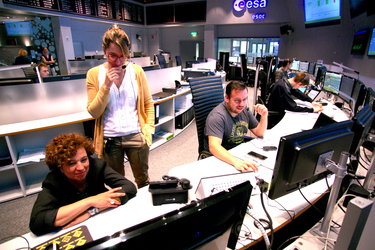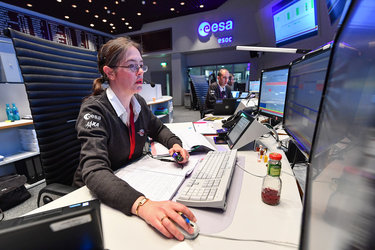Accept all cookies Accept only essential cookies See our Cookie Notice

About ESA
The European Space Agency (ESA) is Europe’s gateway to space. Its mission is to shape the development of Europe’s space capability and ensure that investment in space continues to deliver benefits to the citizens of Europe and the world.
Highlights
ESA - United space in Europe
This is ESA ESA facts Member States & Cooperating States Funding Director General Top management For Member State Delegations European vision European Space Policy ESA & EU Space Councils Responsibility & Sustainability Annual Report Calendar of meetings Corporate newsEstablishments & sites
ESA Headquarters ESA ESTEC ESA ESOC ESA ESRIN ESA EAC ESA ESAC Europe's Spaceport ESA ESEC ESA ECSAT Brussels Office Washington OfficeWorking with ESA
Business with ESA ESA Commercialisation Gateway Law at ESA Careers Cyber resilience at ESA IT at ESA Newsroom Partnerships Merchandising Licence Education Open Space Innovation Platform Integrity and Reporting Administrative Tribunal Health and SafetyMore about ESA
History ESA Historical Archives Exhibitions Publications Art & Culture ESA Merchandise Kids Diversity ESA Brand CentreLatest
Space in Member States
Find out more about space activities in our 23 Member States, and understand how ESA works together with their national agencies, institutions and organisations.
Science & Exploration
Exploring our Solar System and unlocking the secrets of the Universe
Go to topicAstronauts
Missions
Juice Euclid Webb Solar Orbiter BepiColombo Gaia ExoMars Cheops Exoplanet missions More missionsActivities
International Space Station Orion service module Gateway Concordia Caves & Pangaea BenefitsLatest
Space Safety
Protecting life and infrastructure on Earth and in orbit
Go to topicAsteroids
Asteroids and Planetary Defence Asteroid danger explained Flyeye telescope: asteroid detection Hera mission: asteroid deflection Near-Earth Object Coordination CentreSpace junk
About space debris Space debris by the numbers Space Environment Report In space refuelling, refurbishing and removingSafety from space
Clean Space ecodesign Zero Debris Technologies Space for Earth Supporting Sustainable DevelopmentLatest
Applications
Using space to benefit citizens and meet future challenges on Earth
Go to topicObserving the Earth
Observing the Earth Future EO Copernicus Meteorology Space for our climate Satellite missionsCommercialisation
ESA Commercialisation Gateway Open Space Innovation Platform Business Incubation ESA Space SolutionsLatest
Enabling & Support
Making space accessible and developing the technologies for the future
Go to topicBuilding missions
Space Engineering and Technology Test centre Laboratories Concurrent Design Facility Preparing for the future Shaping the Future Discovery and Preparation Advanced Concepts TeamSpace transportation
Space Transportation Ariane Vega Space Rider Future space transportation Boost! Europe's Spaceport Launches from Europe's Spaceport from 2012Latest

Sun sets on a busy year at ESOC
Thank you for liking
You have already liked this page, you can only like it once!
The past year at ESA’s operations centre in Darmstadt, Germany, has seen an extraordinary series of records achieved by the Agency.
Teams at mission operations have controlled 20 satellites during the course of the year, reaching a peak of 22 in November, and guided four satellites and spacecraft through the critical post-liftoff ‘launch and early orbit phase’ (LEOP). Never has ESOC controlled so many satellites in parallel!
From the ExoMars Trace Gas Orbiter to ESA’s star-mapping observatory, Gaia, teams at the centre controlled 13 ESA-owned missions and provided support to many others in 2018.
After the lift off of any satellite comes the treacherous launch and early orbit phase, in which mission controllers guide the fledgling spacecraft into its new life in space, carefully turning on vital components and waking up the spacecraft.
With four LEOPs completed in 2018 – Sentinel-3b, Aeolus, BepiColombo and MetOp-C – ESOC has completed an unprecedented series of 14 LEOPs in the last four years.
With just under 18 days between the launch of BepiColombo and MetOp-C, 2018 saw the shortest period between two LEOPs in ESOC’s 50-year history.
In February, ESOC was buzzing with tense activity as teams completed the critical year-long ‘aerobraking’ campaign for the ExoMars probe at Mars, another first for Europe.
Another highlight of the year was the implementation of an entirely new attitude control mode for Mars Express, which works around its ageing attitude sensors and will allow the probe to extend its lifetime at the Red Planet by many more years.
In the meantime, routine operations of the many other spacecraft in flight continued successfully, with XMM-Newton becoming, on 4 September, the longest-operated mission ever flown from ESOC, with 6843 days in flight.
As the sun sets over ESA’s mission control centre for the last time in 2018, we look forward to the many more exciting adventures ahead, and hope you will join us for them all.
Happy new year!
-
CREDIT
ESA -
LICENCE
ESA Standard Licence

Teams at mission control in BepiColombo simulation

LISA Pathfinder training

BepiColombo SOM Elsa Montagnon

Software coordinator in ESOC's Main Control Room















 Germany
Germany
 Austria
Austria
 Belgium
Belgium
 Denmark
Denmark
 Spain
Spain
 Estonia
Estonia
 Finland
Finland
 France
France
 Greece
Greece
 Hungary
Hungary
 Ireland
Ireland
 Italy
Italy
 Luxembourg
Luxembourg
 Norway
Norway
 The Netherlands
The Netherlands
 Poland
Poland
 Portugal
Portugal
 Czechia
Czechia
 Romania
Romania
 United Kingdom
United Kingdom
 Slovenia
Slovenia
 Sweden
Sweden
 Switzerland
Switzerland























